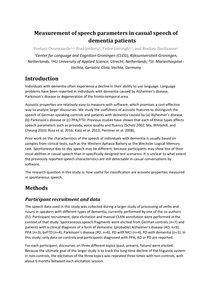From the article: "Individuals with dementia often experience a decline in their ability to use language. Language problems have been reported in individuals with dementia caused by Alzheimer’s disease, Parkinson’s disease or degeneration of the fronto-temporal area. Acoustic properties are relatively easy to measure with software, which promises a cost-effective way to analyze larger discourses. We study the usefulness of acoustic features to distinguish the speech of German-speaking controls and patients with dementia caused by (a) Alzheimer’s disease, (b) Parkinson’s disease or (c) PPA/FTD. Previous studies have shown that each of these types affects speech parameters such as prosody, voice quality and fluency (Schulz 2002; Ma, Whitehill, and Cheung 2010; Rusz et al. 2016; Kato et al. 2013; Peintner et al. 2008). Prior work on the characteristics of the speech of individuals with dementia is usually based on samples from clinical tests, such as the Western Aphasia Battery or the Wechsler Logical Memory task. Spontaneous day-to-day speech may be different, because participants may show less of their vocal abilities in casual speech than in specifically designed test scenarios. It is unclear to what extent the previously reported speech characteristics are still detectable in casual conversations by software. The research question in this study is: how useful for classification are acoustic properties measured in spontaneous speech."
MULTIFILE

A substantial amount of studies have addressed the influence of sound on human performance. In many of these, however, the large acoustic differences between experimental conditions prevent a direct translation of the results to realistic effects of room acoustic interventions. This review identifies those studies which can be, in principle, translated to (changes in) room acoustic parameters and adds to the knowledge about the influence of the indoor sound environment on people. The review procedure is based on the effect room acoustics can have on the relevant quantifiers of the sound environment in a room or space. 272 papers containing empirical findings on the influence of sound or noise on some measure of human performance were found. Of these, only 12 papers complied with this review's criteria. A conceptual framework is suggested based on the analysis of results, positioning the role of room acoustics in the influence of sound on task performance. Furthermore, valuable insights are pre- sented that can be used in future studies on this topic. Whi le the influence of the sound environment on performance is clearly an issue in many situations, evidence regarding the effectiveness of strategies to control the sound environment by room acoustic design is lacking and should be a focus area in future studies.
DOCUMENT

While research has shown the multiple benefits of single-bed patient rooms in hospitals, amongst which the experience of privacy and dignity, the majority of patient rooms in existing hospitals are shared. Transforming them into single-patient rooms can be time-consuming, costly or even impossible, which motivates this study looking into privacy in multiple-patient rooms. To share a hospital room, means to share sensitive information with total strangers. This may cause uncomfortable situations for both patients. Furthermore, the awareness of other ears in the room can withhold some patients from sharing important information during daily ward rounds The aim of this study was to investigate the acoustic effect and the acceptance of an adjustable sound masking system in a 4-bed patient room. The objective of the system is that when a doctor shares personal information with one patient, the other patients in the room are not able to understand the conversation.
LINK